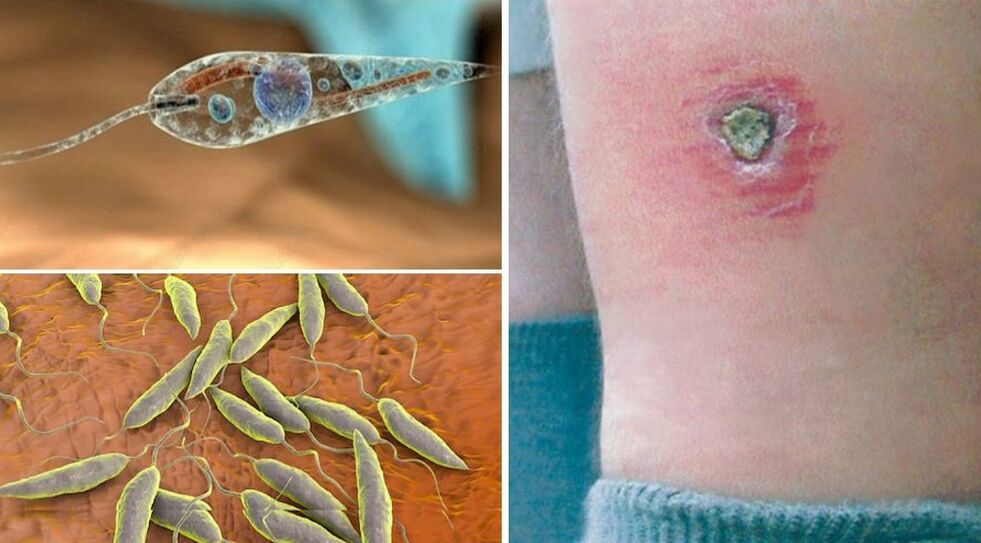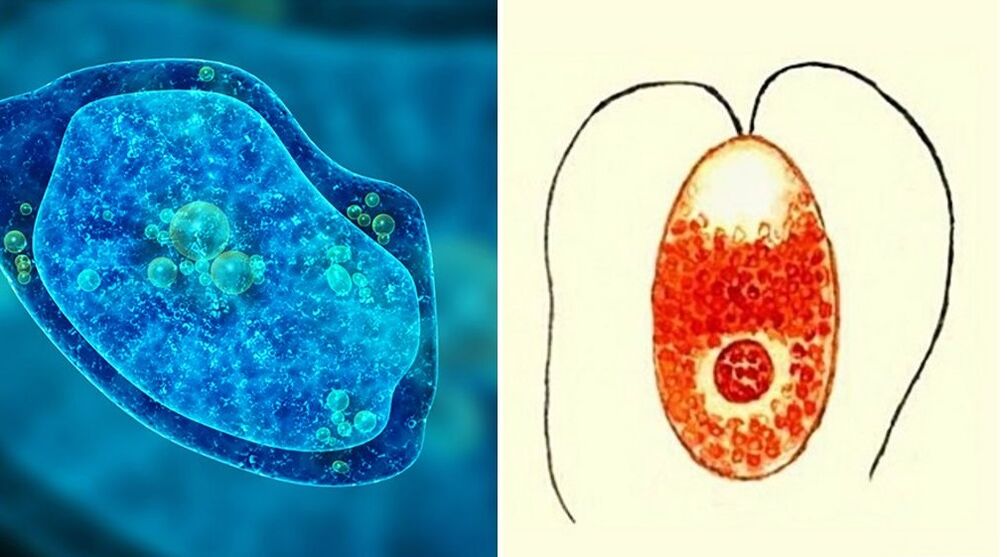Protozoan parasites in humans are the causative agent of protozoan infection (or protozoan disease). These diseases are contagious and threaten serious complications and consequences. Therefore, protozoan diseases require prompt diagnosis, accurate identification of pathogens and appropriate treatment.
What are protozoan parasites
This is a group of single-celled microorganisms that cannot independently produce nutrients. During the course of their lives, they exploit other organisms, causing them to develop serious diseases. The most common human protozoan parasites are listed below:
- Flagella - Giardia, Leishmania, Trichomonas, Trypanosoma;
- sarcodal - dysentery amoeba;
- Ciliates - cysts, balantidia;
- Sporozoites - Plasmodium, coccidia, piroplasms.
Trypanosoma
The simplest parasite whose life cycle takes place in ungulates (antelope) or in an infected person. The carrier is a fly that, when bitten by a human, injects protozoa-laden saliva into his skin.
Notice!
In order to develop the disease (African trypanosomiasis or sleeping sickness), about 400 trypanosoma species need to be introduced. As many as 500, 000 parasites drop in a single bite from a fly.
Characteristics of parasites and diseases:
- Trypanosomes initially circulate in the blood of an infected person, causing trypanosomes on the skin (swollen face, eyelids), fever up to 40°C, swollen lymph nodes;
- The single-celled parasite then migrates into the cerebrospinal fluid, causing lethargy, iridocyclitis, chronic fatigue, lethargy, speech, coordination disturbances;
- Advanced forms of trypanosomiasis are characterized by convulsions of the extremities, seizures, nervous and physical exhaustion, respiratory paralysis, coma, and death.
For the diagnosis of trypanosomiasis, Romanovsky-Gimsa test, immunofluorescence reaction, enzyme immunoassay (ELISA), lymph node puncture are used. Diagnosis is usually confirmed by introducing the patient's blood into laboratory pigs. Sleeping sickness treatment involves taking special medicines. In the absence of highly probable treatments, fatal outcomes for patients are possible.
Lambia
Microscopic protozoa with four pairs of flagella (synonyms - Giardia or Giardia) are full-cycle parasites in the human body. In some cases, they can cause giardiasis. Giardia attaches to the wall of the small intestine as large suckers, often depositing in the ducts of the liver, gallbladder, and other internal organs.
Notice!
In unsanitary conditions, food and water can infect protozoa. Giardia cysts with embryos remain invasive in the environment for long periods of time (up to 3 months in fresh water and up to 4 months in sewage). The diagnosis of protozoa is made by microscopic examination of cysts and adults in feces, blood, and detection of antibodies in ELISA studies.
Leishmania
These flagellated protozoa cause leishmaniasis, which is common in tropical and subtropical countries. Infection occurs in a transmissible way - when bitten by the saliva of blood-sucking insects, animals (dogs, ground squirrels). Mosquitoes, mosquitoes, gadflies, ticks can be vectors. There are two types of leishmaniasis in humans:
- Cutaneous and mucocutaneous forms (pendinskaya ulcers) - Leishmania live and multiply in human skin, causing inflammation, swelling, ulcers, trophic ulcers, respiratory tract damage;
- Visceral form - Leishmania is present in internal organs (spleen, liver, lungs, heart).
A characteristic sign of cutaneous leishmaniasis is the formation of brown nodules (leishmaniasis) at the site of the insect bite. They are then replaced by round, hard-to-heal ulcers with purulent exudate. The disease can last 1-2 years and leave scars on the skin. In the visceral form, leishmaniasis causes dysfunction of the adrenal glands, kidneys, liver and spleen. When leishmania are diagnosed, they are present in the bone marrow, lymph nodes, skin scrapings, and blood.

Notice!
Treatment of leishmaniasis includes isolation measures, patient isolation and medication.
Trichomonas
These are the simplest parasites in the human internal environment, transmitted through sexual transmission, household contact, or infection from mother to child. Trichomonas have oral, intestinal and genitourinary varieties. Protozoa are causative agents of trichomoniasis/trichomoniasis. Urogenital trichomoniasis of the genitourinary system is common. The chronic form of the disease threatens impotence and persistent infertility. Features of Trichomonas parasitism:
- Body size - up to 18 microns, moving fast due to flagella movement;
- drug resistance, to determine the chronic course of trichomoniasis;
- In direct sunlight, rapid death in the environment and air;
- Left on wet towels, sponges, towels, soap dishes for long periods of time;
- Frequent infections during vaginal, oral-vaginal intercourse;
- Trichomonas contributes to the development of candidiasis, vulvitis, chlamydia, gonorrhea, cystitis.
Diagnosis of trichomoniasis involves testing for trichomoniasis in genital swabs. Treatment includes the use of drugs, treatment with antiseptics. Treatment is performed on both sides to avoid recurrence. Prevention of urogenital trichomoniasis includes measures recommended for all sexually transmitted diseases.
dysentery amoeba
This sarcode microbe is a parasite that causes dangerous diseases in humans. There are two forms of dysentery amebiasis - enteric and parenteral (liver or lung). The disease begins 7-10 days after symptoms of infection - bloody diarrhea, fever, vomiting.
If left untreated, the consequences of amebiasis develop - dehydration, exhaustion, weakness, internal bleeding, liver abscess. Infection occurs most often through the oral-fecal route. Carriers of amoeba cysts can be insects - flies, gadflies. During diagnosis, protozoa in the form of tissues were found in feces. Treatment of amebiasis is fixed, with antibiotics.

Plasmodium
Representative of the simplest sporozoites, the causative agent of a dangerous disease - malaria. The human body acts as an incubator for the parasite's life cycle to occur. Parasitic features:
- Plasmodium sporozoites are infected when bitten by Anopheles mosquitoes;
- The sporozoites enter the bloodstream with the saliva of the infected insect;
- The sporozoites settle in the liver, penetrate into their cells (hepatocytes);
- Here merozoites are formed by mitotic replication;
- When liver cells are destroyed, merozoites infiltrate red blood cells;
- Due to the sexual cycle, merozoites form gametophytes;
- Mosquitoes acquire gametophytes when bitten by an infected person;
- In mosquitoes, the gametophyte enters the oocyst and then the sporozoite;
- A mosquito infects a healthy person, and the cycle goes on and on.
The destruction of red blood cells and the release of gametocytes into the bloodstream accompany fever, vomiting, anemia, convulsions and joint pains in humans. In severe cases, the risk of death increases. Malaria is usually relapsing, with exacerbations and resting phases. Different protozoa cause tropical malaria, three and four days. The main therapeutic and diagnostic agent is quinine - natural or synthetic from cinchona.
Escherichia coli
The causative agent of the disease balantidia (or infusion dysentery) lives in the large intestine, causing bleeding ulcers on its walls. Protozoan infection occurs in livestock, and the main vector is pigs. Anatomical and Parasitic Features:
- The body of balantidia is oval with a dense, firm outer shell (pellicle);
- There are many cilia on the surface, which are used for movement;
- The sexual form of the parasite is necessary for reproduction by simple fission;
- Asexual forms (cysts) enter the environment with feces;
- The route of infection of cysts in humans is oral-faecal.
The relocation of protozoa in the gut is accompanied by headaches, vomiting and indigestion in humans. The acute phase of balanitis is characterized by a feverish state, signs of severe poisoning, and loose stools with blood clots. Without prompt treatment, it can lead to fatal consequences.
Toxoplasma gondii
Microscopic crescent-spore protozoa from the order Coccidia are widely distributed in the environment. They are the causative agent of the disease - toxoplasmosis. In healthy people, ingested pests are destroyed by immune cells. Characteristics of diseases caused by human protozoan parasites:
- Toxoplasmosis is often asymptomatic, and immunity develops after recovery;
- Parasites affect the visual organs, reproduction, nerves, lymphatic system, liver, spleen;
- During pregnancy, toxoplasmosis can cause serious congenital disease or death of the fetus;
- The acute form is accompanied by convulsions, paralysis, liver enlargement, heart problems;
- In a chronic course, cardiac dysfunction and damage to the visual organs may result.
The main hosts of protozoa are cats. Inside their bodies, giant Toxoplasma colonies are formed from oocysts. Humans are the intermediate hosts and are infected through the digestive tract, household contact, or the oral and fecal routes.






































